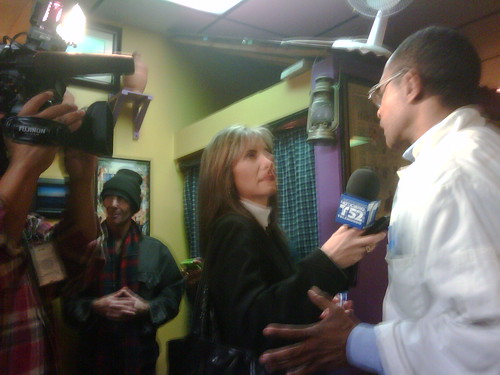Haiti Earthquake, Social Networks and Perfect Information January 15, 2010
Posted by lborodkin in : Uncategorized , add a commentCameraphone picture: We all interview each other (via flickr)
Here’s my post from LAist on the local fundraiser at TiGeorges’ Chicken in Echo Park to benefit the Haitian earthquake relief efforts. The restaurant raised $14,000 from about 300 people – a pretty generous average gift of $47 per person.
Several news crews were there doing video and stories. Gigi Graciette of Fox 11 interviewed me and others for a story on the text messaging campaign and the significance of social media in this disaster. My Blackberry makes an appearance in Gigi’s terrific piece for the local Fox 11 news (as do I):
Last night’s event felt very much like a turning point. Newsmakers swapped places with the news gatherers. The means of distribution became the story itself. Everyone was wandering around TiGeorges, wanting chicken, and taking pictures of the news crews, announcements and each other with their smart phones and cameras.
The time for relaying news of world-wide events approaches zero. The former subjects of news stories can now relay first-person accounts of news events. (Tweets from Haiti from @troylivesay @fredodupoux @carelpedre @RAMhaiti tell the tale).
So what does that mean and where are we heading?
Perhaps the over $10 million raised by the text-messaging campaign is proof of concept of the moral equivalent of the Nobel-prize winning Coase Theorum. (The Coase Theorum supposes that with zero transaction costs, private parties will reach the most economically efficient result.) Perfect information leads parties towards a perfectly efficient result in the market. Or something like that.
Markets are not just for money. There are markets for reputation (some say “whuffie”), trust, morality, and numerous other unquantifiable qualities.
In the marketplace of social responsibility, the cellular carriers’ micropayment systems and voluntary waiver of their own administrative costs largely eliminated transaction costs. Donors knew that 100% of their money (in Wyclef Jean’s Yele program, 91% in the Red Cross program) was going to relief efforts, not the carriers.
Donations were also anonymous, which eliminated the potential self-interest of donation as quasi-advertising. Social media users tend to be in the more affluent sectors of society, but this type of giving did not come with the expectation of have name recognition.
With perfect information, negligible transaction costs and no conflict of interest, people saw the news, heard the pleas, and decided to give a total of over $10,000,000 — $5 and $10 at a time. People want to help others in need, when the barriers to information are removed and donation is easy.
Perhaps the phenomenon could be taken as proof that the morally efficient result of a “Coasean,” connected world is compassion.
That should bump anyone’s faith in the basic goodness of humanity.





 del.icio.us
del.icio.us flickr
flickr LinkedIn
LinkedIn Twitter
Twitter


